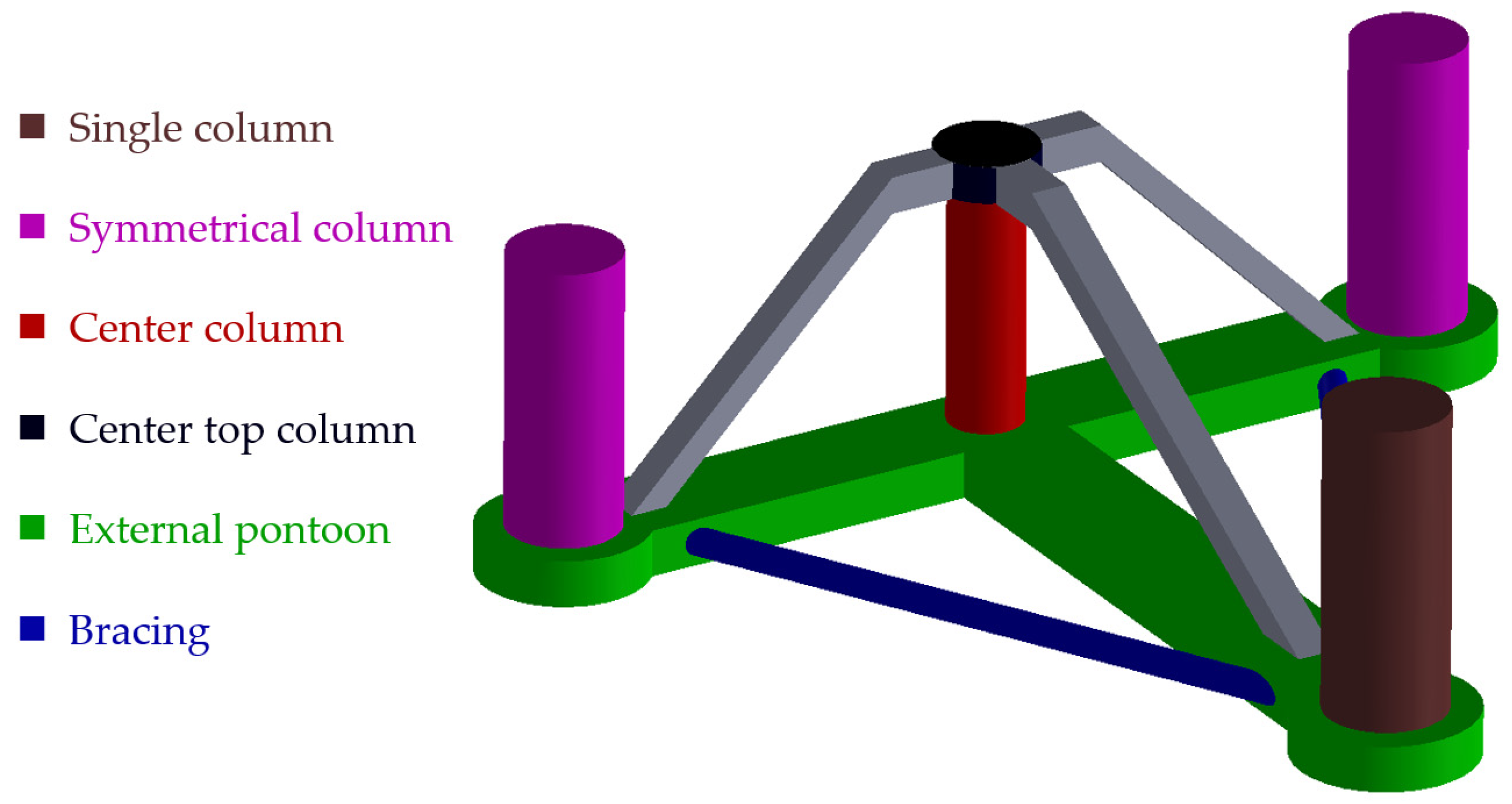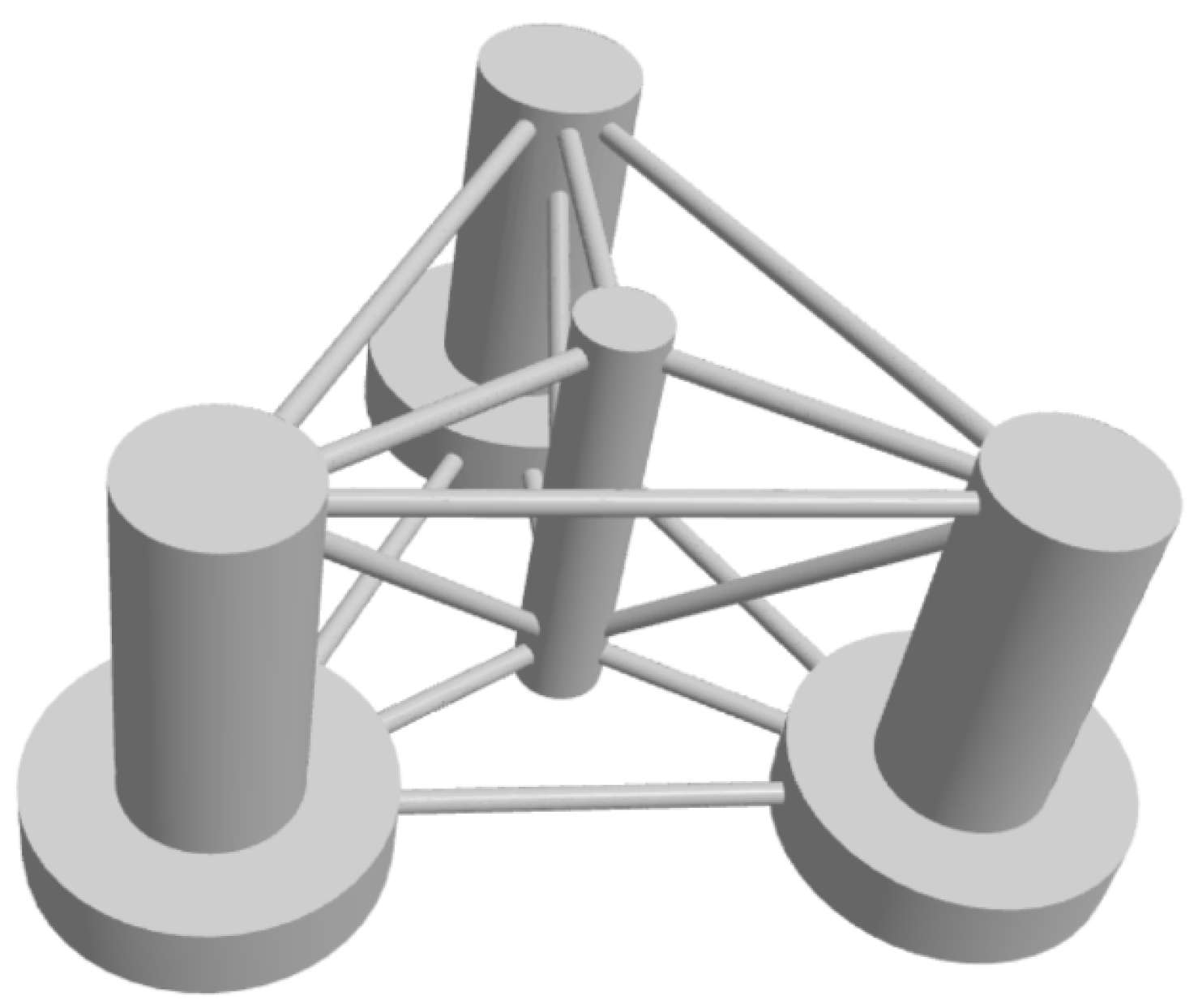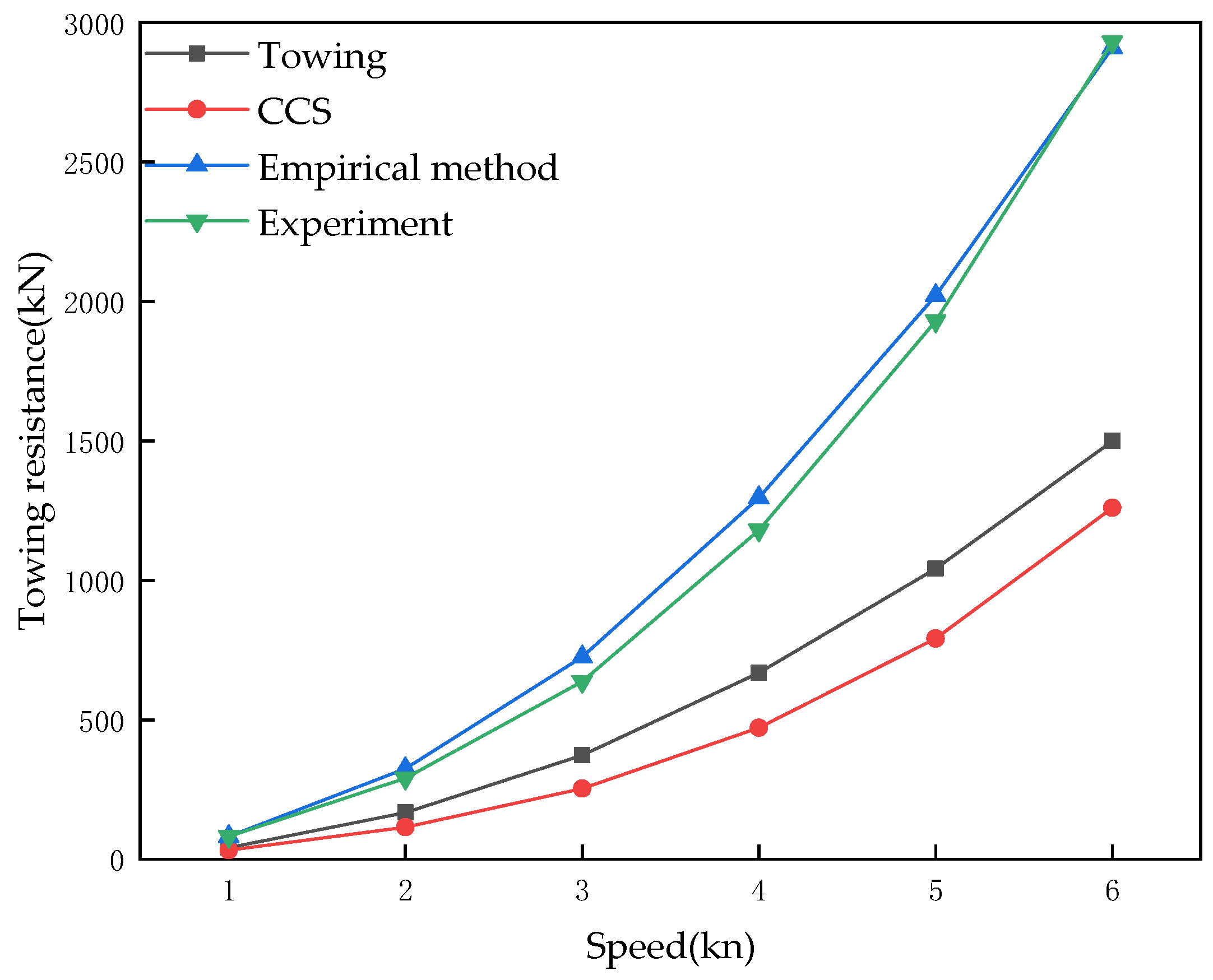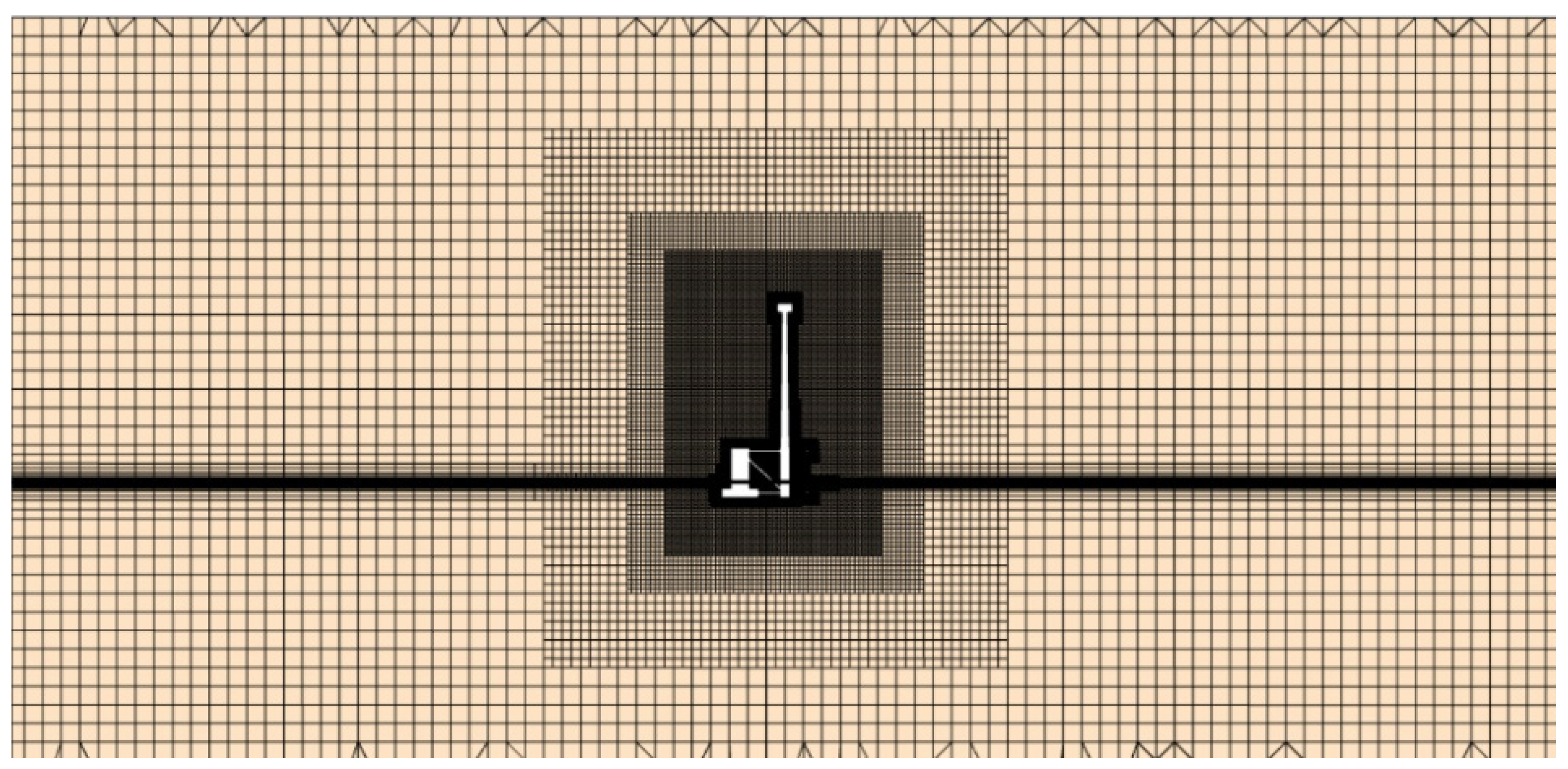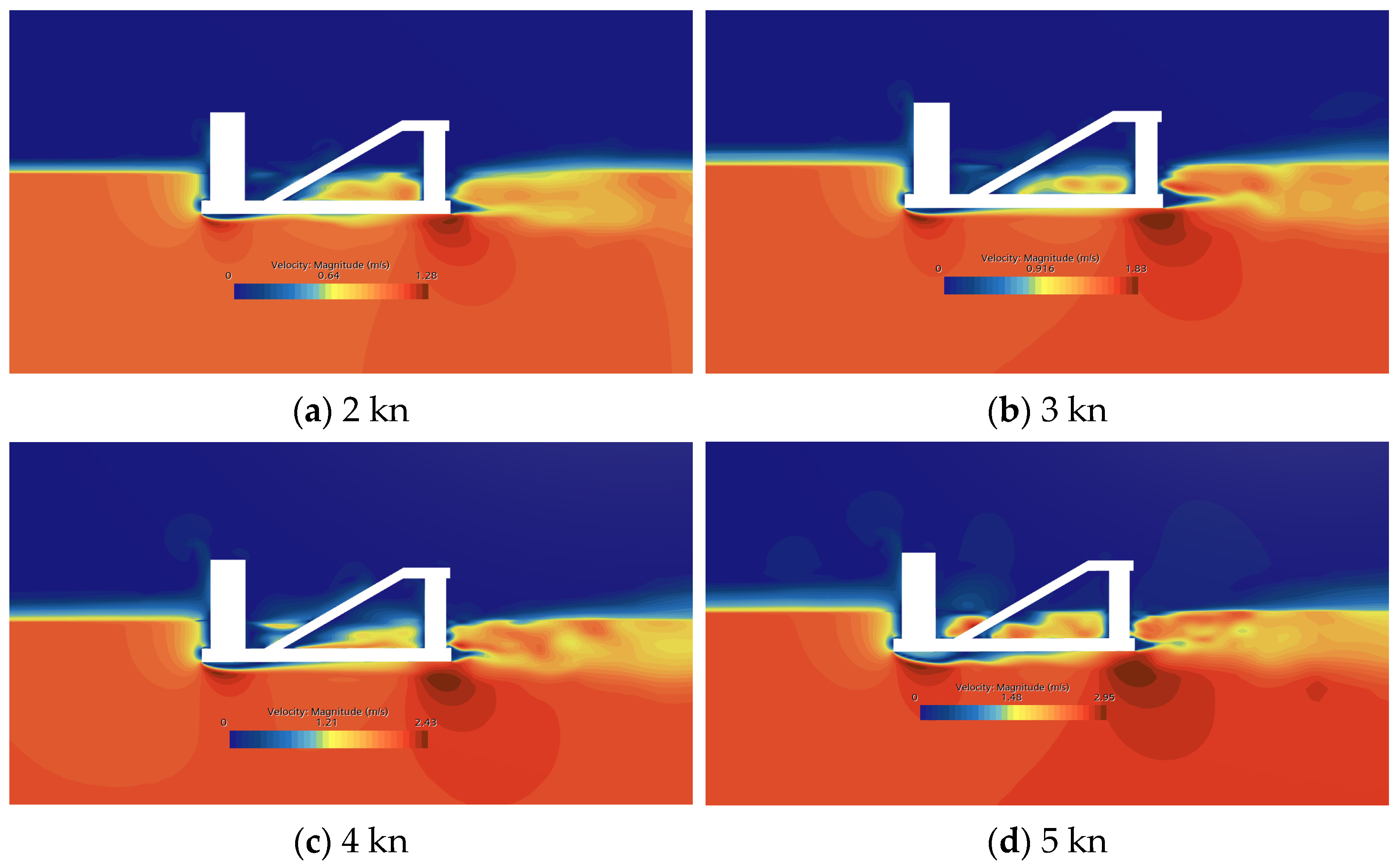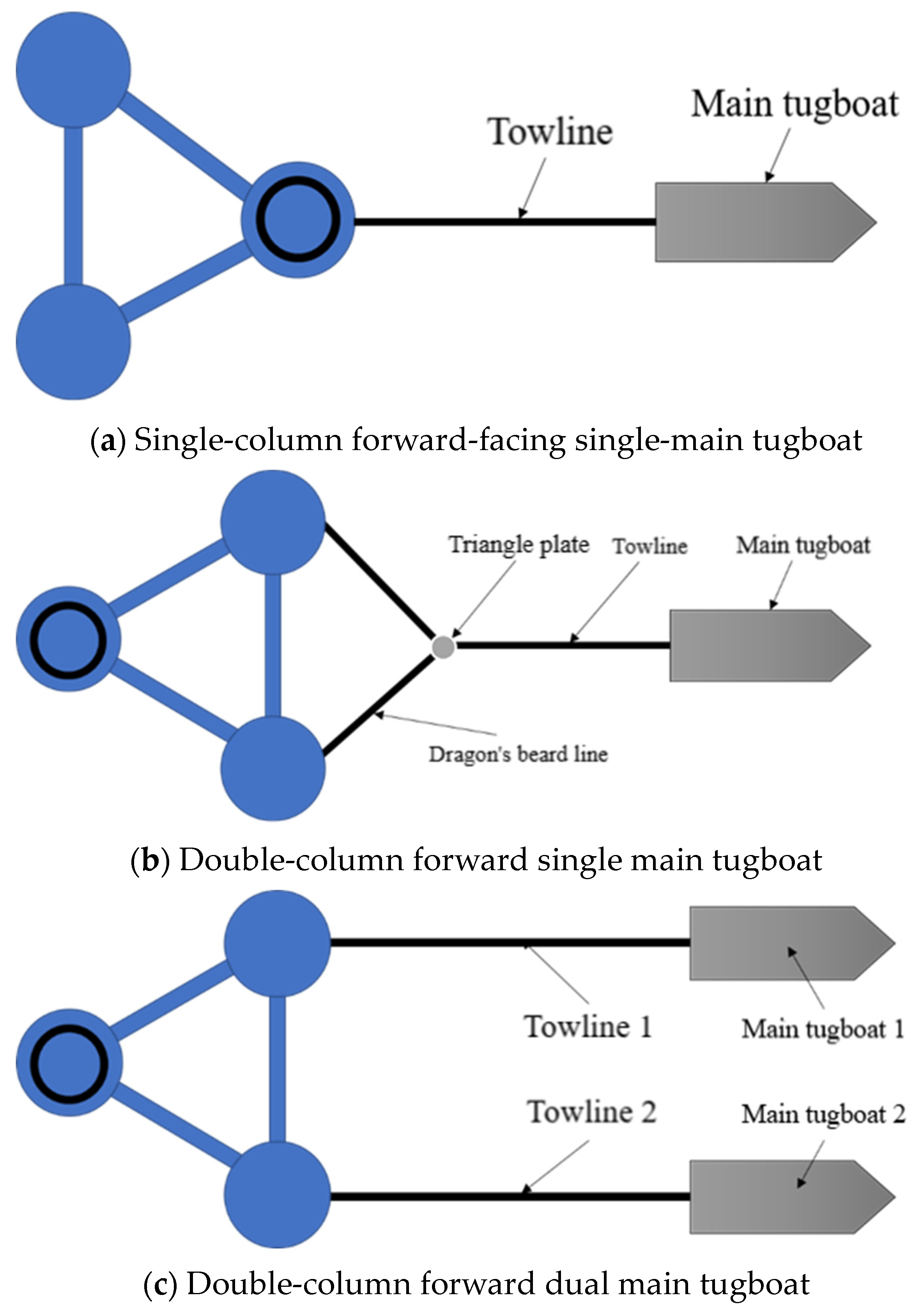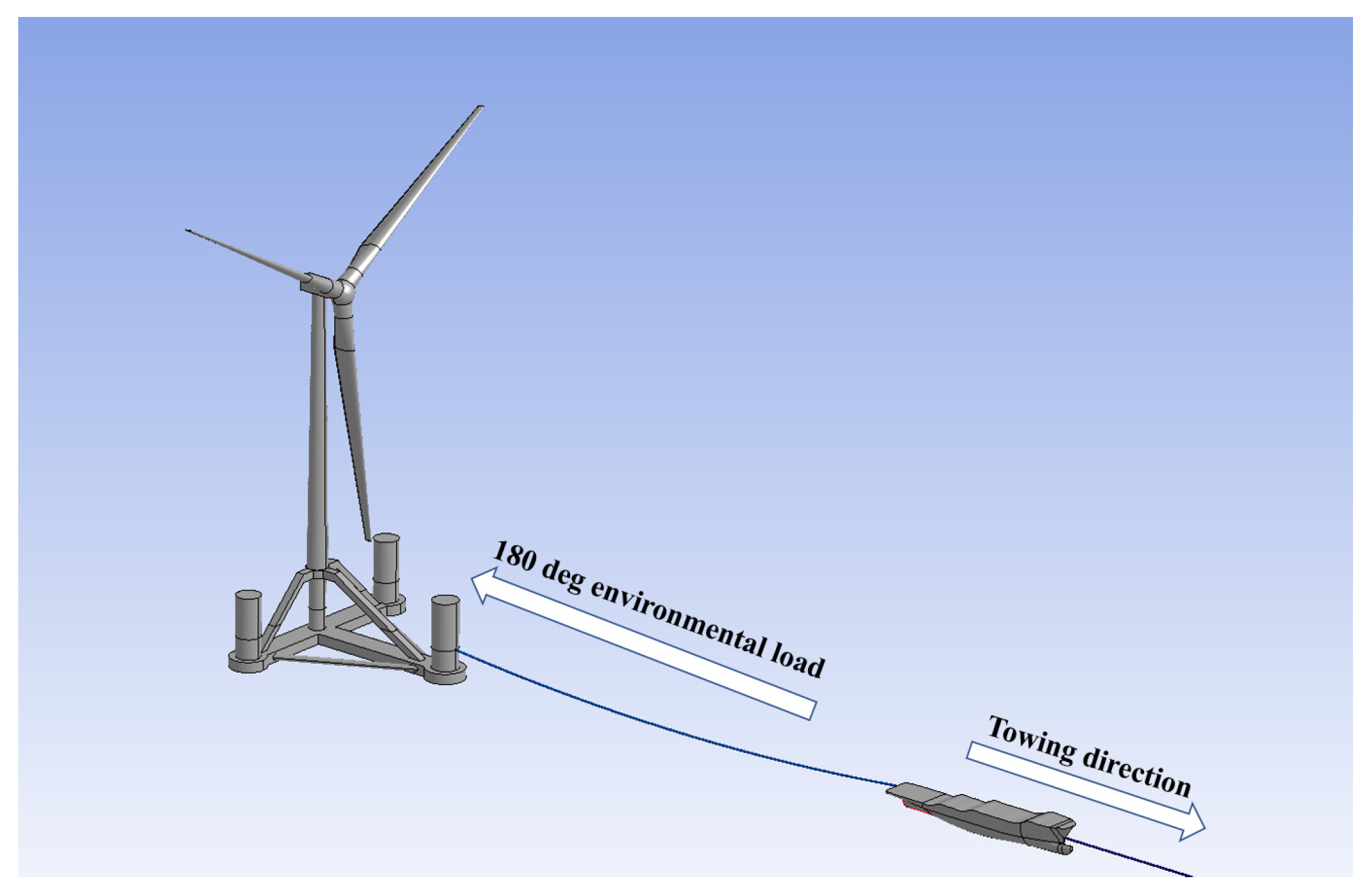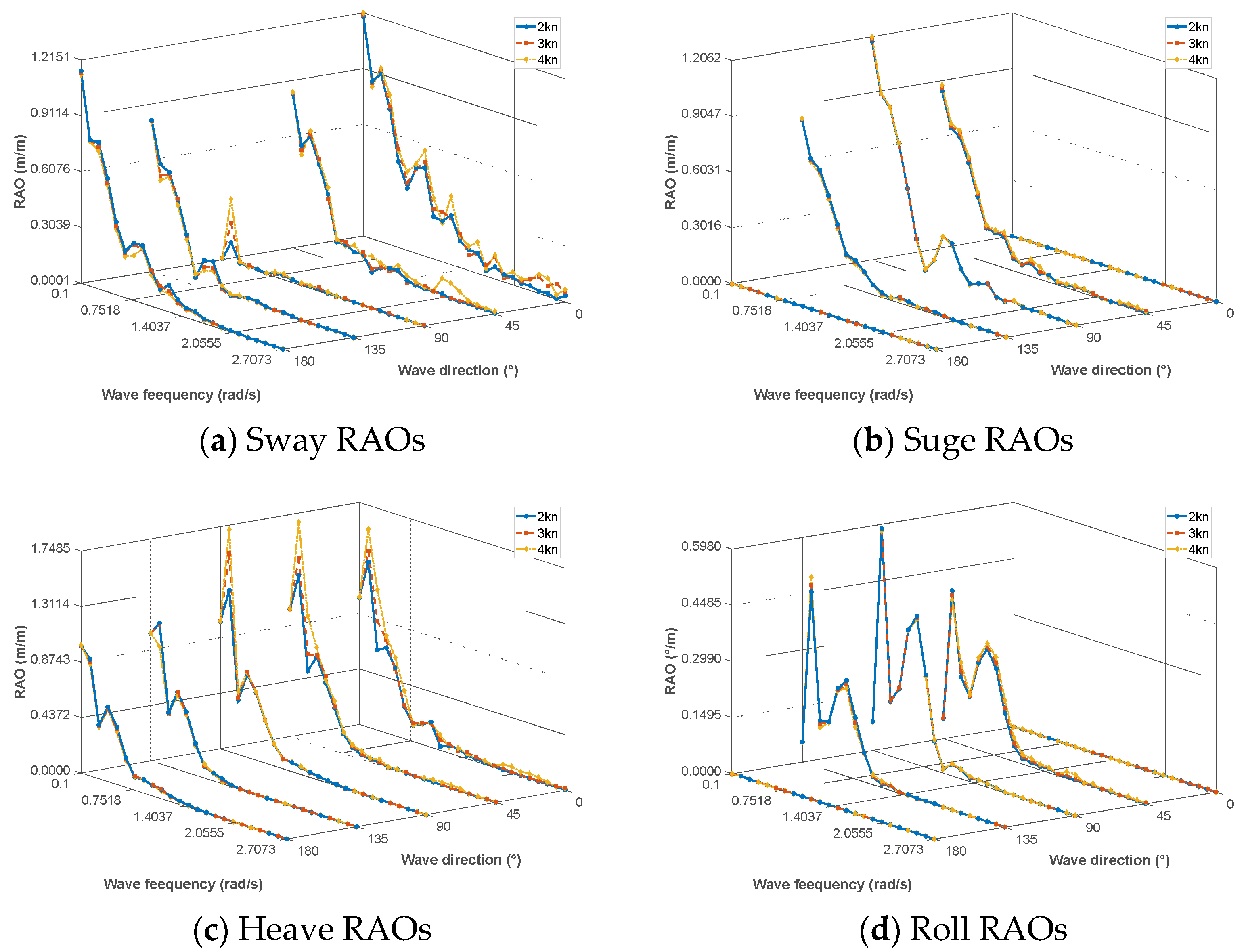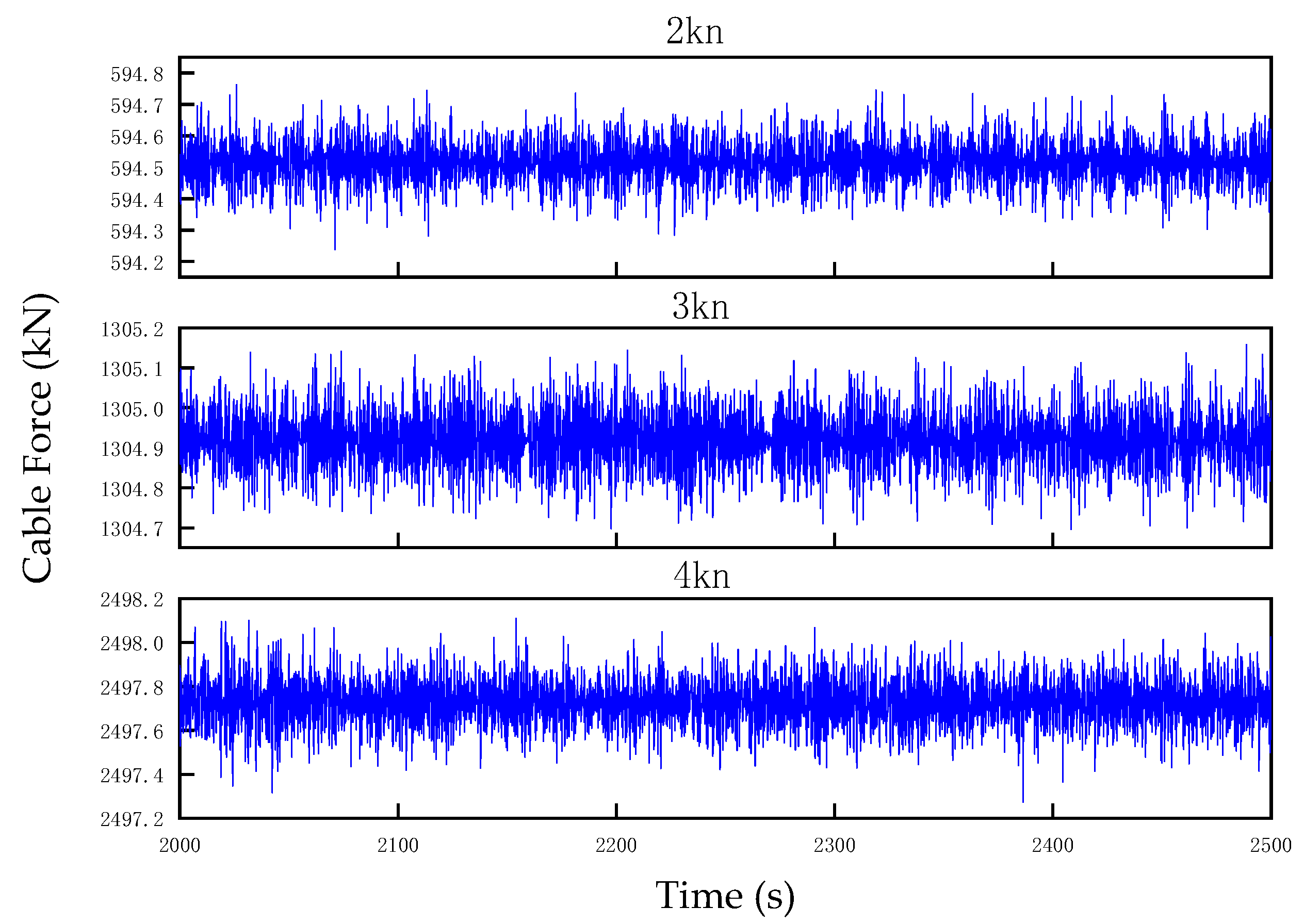1. Introduction
With the continuous growth of global energy demand and the high attention to renewable energy, offshore wind power, as a green and clean energy form, is becoming an important part of the global energy transformation [
1]. In particular, the emergence of floating wind turbines (FOWT) provides new possibilities for installation in complex waters, such as offshore and deep waters. However, compared with fixed wind turbines, floating wind turbines face more technical challenges in design, towing, and operation and maintenance, including dynamic stability, system response characteristics, and long-term reliability [
2]. Jiang et al. [
3,
4,
5] discussed and analyzed the foundation types, installation technologies, and operation and maintenance (O and M) of FOWT, highlighting the challenges faced by FOWTs and future research directions. Similarly, Hu et al. [
6] presented a comprehensive review on the key technologies related to the installation, operation, and maintenance of FOWT and provided a summary of the challenges and future development directions.
These challenges bring an urgent need to conduct in-depth research on the overall performance of floating wind turbines during towing operations. In recent years, the academic and engineering communities have made significant progress in the research of floating wind turbine towing stability and proposed a variety of new evaluation methods and optimization strategies, which provide a solid theoretical basis for the stability and reliability of floating wind turbines. Researchers have established a series of numerical models to analyze the dynamic behavior and motion response of floating wind turbines. Ramachandran et al. [
7] used numerical tools to predict the motion of floating wind turbines and proposed a hybrid method combining potential flow theory and the Morison method. They compared the experimental results and verified their effectiveness. Kim et al. [
8] combined OPENFOAM, OPENFAST, and MoorDyn to simulate the aerodynamics, servo control, hydrodynamics, and mooring systems of floating wind turbines and studied the complex dynamic response of wave-structure interaction. Ishihara et al. [
9] proposed a semisubmersible platform equipped with three wind turbines. They studied its motion response under combined wind and wave conditions through numerical simulation and water tank tests, providing new ideas for the design of floating platforms. Luan [
10] et al. proposed a concept of an unsupported steel semisubmersible floating wind turbine and verified its overall stability, natural period, and vibration mode performance through numerical analysis. Ma et al. [
11] proposed an integrated method of tower-nacelle-rotor assembly for floating wind turbine installation. Jonkman [
12] developed a fully coupled time domain simulation tool that combines multiple modules, such as wind power generation, ocean dynamics, and servo systems, to study the dynamic behavior of offshore floating wind turbines. Zhao [
13] studied the extreme response estimation method of floating offshore wind turbines and introduced a 4-dimensional inverse first-order reliability method (IFORM) that combines the environmental contour method (ECM) with a proxy model. Shanahan [
14] studied the impact of wind speed and wind-wave mismatch on the performance of floating wind turbines and found that the greater the wind speed, the smaller the wind-wave mismatch angle, while in extreme weather conditions such as hurricanes, the wind-wave mismatch effect may be enhanced. Lotfizadeh et al. [
15] conducted a life cycle assessment of the Hywind Tampen floating offshore wind farm. The study showed that environmental optimization during the manufacturing stage is the key to reducing the overall environmental burden. Barile [
16] proposed a new CFD method for simulating atmospheric boundary layer wind tunnel flows and verified its advantages in the study of floating wind turbine wakes. Zhao et al. [
17] proposed a small-diameter floating semisubmersible platform for enhanced stability and cost-effectiveness. Ronold et al. [
18] pointed out that the existing offshore wind turbine design standards are mainly based on the experience of fixed wind turbines and do not fully consider the specific needs of floating platforms. The octagonal barge-type platform and the new tower damping system proposed by Sun et al. [
19] can significantly improve the stability of floating wind turbines under different sea conditions. Belvasi [
20] discussed the calibration of hydrodynamic viscous damping of floating wind platforms through computational fluid dynamics (CFD) models and further explored the application of simplified computational fluid dynamics models in calibrating hydrodynamic viscous damping of floating wind platforms. Yang et al. [
21] proposed a new type of wind-wave combined power generation system and, through the analysis of the mooring system, put forward a practical mooring optimization method. Huang et al. [
22] analyzed the hydrodynamic performance of the platform, established a comprehensive analysis model for a 15 MW floating wind turbine, compared the performance of single-section and multisection mooring systems in terms of platform positioning, mooring line limit load, fatigue response, etc., and studied the effects of wind and wave incident angle, mooring line extension angle, mooring line length, and other factors on mooring performance and safety. Jiang et al. [
23] studied the optimization of the mooring system of a 10 MW semisubmersible offshore wind turbine based on a combined method of neural network and genetic algorithm to reduce cost and ensure safety. Tian et al. [
24] developed a novel tower damping system that can significantly reduce the displacement and acceleration of floating wind turbines during operation and extreme sea conditions and extend the maintenance life. For the calculation of multibody models, Zou et al. [
25] proposed a Constant Parameter Time Domain Model (CPTDM). This model combines the Damping Lid Method and the State-Space Model (SSM) to improve the calculation accuracy and efficiency. Chen et al. [
26] studied the numerical modeling of the Catamaran Float-over Deck Installation on Spar platforms, focusing on the complex hydrodynamic interactions and mechanical coupling effects.
The current operation and maintenance of FOWTs face multiple challenges in terms of technology, economy, and operation. McMorland et al. [
27] emphasized the core directions of future operation and maintenance research, including the application of artificial intelligence, automated maintenance, and new maintenance tools to reduce operating costs and improve reliability. Centeno [
28] compared strategies for large component repairs on floating offshore wind turbines, noting that an on-site replacement strategy reduces downtime in the short term, while tugboat maintenance may be better suited for longer-term tasks.
Scholars and researchers have also explored the development model of combining offshore wind power with different marine energy and resources. Chen et al. [
29] designed a multifunctional marine platform that combines floating wind turbines, wave energy converters (WECs), and deep-sea aquaculture cages to improve the stability of wind turbine power generation and the utilization rate of marine resources. Zhang et al. [
30] explored an innovative wind-wave hybrid power generation platform, which integrates a semisubmersible floating wind turbine foundation with a point absorber WEC. They focused on the size optimization of the WEC.
The optimization of the drag resistance and motion characteristics of floating wind turbines is also a research focus. Based on the framework of maritime merchant ship safety rules and the design standards of the oil and gas industry, Collu et al. [
31] proposed a new whole-machine towing stability assessment standard, which provided an important basis for the structural design of FOWT. Berg [
32] developed a model to estimate the tension response of the streamer cable to determine the towing limit of a semisubmersible drilling rig. Chen et al. [
33] used STAR-CCM+ software to analyze the towing resistance of a 5 MW floating wind turbine and studied the motion response during the overall towing process through flow coefficient simulation. Hyland et al. [
34] optimized the motion response and resistance of GICON
®-TLP under different towing schemes and working conditions through water tank tests. Ding et al. [
35] analyzed the two towing modes, surface towing and submerged towing, through numerical simulation and conducted a comparative analysis on their towing resistance, towing speed, towline mooring position, and motion response. Ding et al. [
36] studied the effects of water depth and speed on cabin pressure and pitch angle during towing. The results showed that under different drafts and speeds, the cabin pressure changes little, and the stability during towing is good. Le et al. [
37] studied the drag and towing performance of two FOWTs with similar mass and different wave conditions by comparing numerical models with experimental data and found that both structures performed well when the wave height was less than 5 m. Guo et al. [
38] studied the scale effect of large-scale model towing tests and recommended a hybrid format of the ITTC-1957 formula and the Grigson formula to improve the accuracy of large ship resistance prediction. Jayachandran [
39] studied the impact of different towing points on the tilt angle of wind turbines and verified the engineering value of traditional static analysis methods and coupled dynamic modeling in safety assessment. Qi et al. [
40] comprehensively summarized the dynamic response and mechanical characteristics of cables and towed objects in towing systems and pointed out the potential for future research. Zhang et al. [
41] studied the dynamic characteristics of the rigid truss trawl system and the flexible trawl system. Hope [
42] proposed a multibody dynamics analysis method and verified its engineering value in towing safety assessment through the Hywind Tampen case.
Based on the above work, this paper proposes a research method for towing resistance of floating wind turbines to achieve the purpose of quickly predicting tow resistance and guiding tug selection. First, the CFD method was used to study the towing resistance of the OC4 platform, and the accuracy of the CFD method was verified by comparison with experiments. Subsequently, the resistance of a new type of floating wind turbine platform in still water was analyzed, and different resistance calculation methods were combined to compare and analyze the resistance prediction results. The resistance prediction method used can predict the tow resistance more accurately. The integrated towing model of floating wind turbines was established by ANSYS-AQWA, and the influence of waves and wind on towing resistance was further analyzed.
